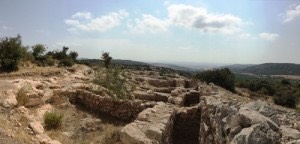Ancient City Unearthed Where David Battled Goliath
Maayan Jaffe-Hoffman / JNS.org

The site where archaeologists believe David battled Goliath. Credit: Maayan Jaffe-Hoffman.
JNS.org — Archaeologists believe they have found the location of the battle between David and Goliath, narrated in the Book of Samuel, in a mysterious two-gated city from the early 10th century.
Known by its modern name, Khirbet Qeiyafa, the site is located in the the Elah Valley, 20 miles southwest of Jerusalem. The excavation project took nearly seven years, and was led by Professor Yosef Garfinkel, the Yigal Yadin Chair of Archeology at Hebrew University’s Institute of Archeology in Jerusalem, together with Sa’ar Ganor from the Israel Antiquities Authority and Professor Michal Hazel of Southern Adventist University of Tennessee.
Through the carbon dating of some 28 charred olive pits, the archaeologists were able to date the city back to the time of Kings Saul and David.
Among the site’s unique features are its two gates, one facing west, toward Philistia, and one to the south, facing Judah. The presence of multiple gates for a relatively small city of 5.7 acres is unusual, according to Bible Lands Museum curator Yehuda Kaplan, and it was this discovery that led excavators to identify it as the city where David fought Goliath, as the biblical name for that location is “Sha’arayim,” Hebrew for “two gates.”
Archaeologists concluded that Khirbet Qeiyafa was a Judean site partly because of the style of pottery found, of which less than 2 percent was comparable to typical Philistine pottery. According to Kaplan, a minimum of 20 percent of the pottery designs would have been Philistine if the community had not been Judean. Of the 24 weapons and tools discovered, 67 percent were made from iron and 33 percent from bronze, results similar to archaeological finds elsewhere in the biblical Kingdom of Judah, such as in Arad and Beersheba.
The Jewish presence at Khirbet Qeiyafa was corroborated by the presence of thousands of sheep, goat, cow and fish bones, and the absence of non-kosher pig bones, Kaplan said.
Evidence of cultic activity was also unearthed, as well as two inscriptions written in the Canaanite script. One was incised on a jar and contains the Hebrew name “Eshbaal [man of Baʿal], son of Beda.” The second was inscribed on a pottery shard with only a few identifiable words, including “king” and “judge.”
Many of the letters reflect Hebraic writing, and Garfinkel said he believes this is the earliest written documentation of the Hebrew language discovered to date.
The site’s casemate walls — or the construction of two thin, parallel walls, with space left in between, and an abutting belt of houses — are also reminiscent of the type of urban planning found only in Judah and Transjordan.
The Khirbet Qeiyafa discoveries have sparked debate, intriguing historians and archaeologists since they were first revealed, but Professor Garfinkel said, “No one can argue with this data.”
“The biblical tradition has historical memory,” Garfinkel added. “If we ask where archaeology supports biblical tradition, we start with Khirbet Qeiyafa.”
“Everything you touch at Khirbet Qeiyafa brings you to this biblical period,” Kaplan said.
The site has also served a modern political purpose.
Some claims made by Biblical Minimalists — scholars and archaeologists who try to deny the connection of the Jewish people to the land of Israel by claiming there’s no reliable evidence of ancient Judean kingdoms — can be negated by findings at Khirbet Qeiyafa.
However, within days of Garfinkel publishing his first paper on his research, another article claimed the city was historically Palestinian.
“This happens a lot,” explained Jacob L. Wright, associate professor of Hebrew Bible studies at Emory University in Atlanta. “In no other area of the world do you have such a connection to the biblical imagination.”
However, Wright said, “One has to separate the bible and archaeology… The Minimalists want to deny the state of Judah and Israel; they are politically driven and have a loose agenda… But it does not help when the ‘maximalists’ try to connect everything they find on the ground with Jesus or King David.”
There’s only one other archaeological reference to King David found in Israel, an Aramaic inscription from the mid-9th century BCE uncovered at Tel Dan. This inscription is attributed to Hazel, king of Damascus, who boasts about killing a king of Israel and a king of Judah, the latter of which is referred to as “King of the House of David.”
The public can now explore the archaeological findings of Khirbet Qeiyafa in a new Bible Lands Museum exhibition entitled “In the Valley of David and Goliath,” which opened earlier this week in Jerusalem.